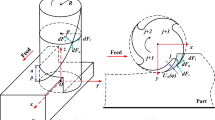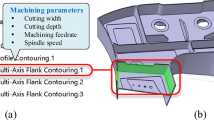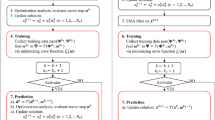Abstract
Large thin-walled structural parts have been widely used in aircrafts for the purpose of weight reduction. These parts usually contain various thin-walled complex structures with weak local stiffness, which are easy to deform during machining if improper machining parameters are selected. Thus, local stiffness has to be seriously considered during machining parameter planning. Existing stiffness calculation methods including mechanical methods, empirical formula methods, finite element methods, and surrogate-based methods are either inaccurate or time consuming for complex structures. To address this issue, this paper proposes a data-driven method for predicting local stiffness of aircraft structural parts. First, machining regions of aircraft structural part finishing are classified into bottom, sidewall, rib, and corner to further define the minimum stiffness of machining regions. By representing the part geometry with attribute graph as the input feature, while computing the minimum stiffness using FEM as the output label, stiffness prediction is turned to a graph learning task. Then, graph neural network (GNN) is designed and trained to map the attribute graph of a machining region to its minimum stiffness. In the case study, a dataset of aircraft structural parts is used to train four GNN models to predict the minimum stiffness of the defined four types of machining regions. Compared with FEM results, the average errors on the test set are 6.717%, 7.367%, 7.432%, and 5.962% respectively. In addition, the data driven model once trained, can greatly reduce the time in predicting the stiffness of a new part compared with FEM, which indicates that the proposed method can meet the engineering requirements in both accuracy and computational efficiency.











Similar content being viewed by others
References
Herranz S, Campa FJ, López de Lacalleet LN, Rivero A, Lamikiz A, Ukar E, Sánchez JA, Bravo U (2005) The milling of airframe components with low rigidity: a general approach to avoid static and dynamic problems. Proc inst Mech Eng Part B J Eng Manuf 219(11):789–802. https://doi.org/10.1243/095440505x32742
Zhao W, Li YG, Liu CQ, Shen WM (2016) A cutting parameter optimization method based on dynamic machining features for complex structural parts. 2016 IEEE 20th International Conference on Computer Supported Cooperative Work in Design (CSCWD). IEEE 85–90. https://doi.org/10.1109/CSCWD.2016.7565968
Jia ZY, Lu XH, Gu H, Ruan FX, Liang SY (2021) Deflection prediction of micro-milling Inconel 718 thin-walled parts. J Mater Process Technol 291:117003. https://doi.org/10.1016/j.jmatprotec.2020.117003
Ma JW, He GZ, Liu Z, Qin FZ, Chen SY, Zhao XX (2018) Instantaneous cutting-amount planning for machining deformation homogenization based on position-dependent rigidity of thin-walled surface parts. J Manuf Process 34:401–411. https://doi.org/10.1016/j.jmapro.2018.05.027
Wang XZ, Li ZL, Bi QZ, Zhu LM, Ding H (2019) An accelerated convergence approach for real-time deformation compensation in large thin-walled parts machining. Int J Mach Tools Manuf 142:98–106. https://doi.org/10.1016/j.ijmachtools.2018.12.004
Qian C, Ye WJ (2021) Accelerating gradient-based topology optimization design with dual-model artificial neural networks. Struct Multidisciplinary Optim 63:1687–1707. https://doi.org/10.1007/s00158-020-02770-6
Tang AJ, Liu ZQ (2008) Deformations of thin-walled plate due to static end milling force. J Mater Process Technol 206(1–3):345–351. https://doi.org/10.1016/j.jmatprotec.2007.12.089
Wu Q, Li DP, Ren L, Mo S (2016) Detecting milling deformation in 7075 aluminum alloy thin-walled plates using finite difference method. Int J Adv Manuf Technol 85(5–8):1291–1302. https://doi.org/10.1007/s00170-015-8012-3
Gao HJ, Zhang YD, Wu Q, Li BH (2018) Investigation on influences of initial residual stress on thin-walled part machining deformation based on a semi-analytical model. J Mater Process Technol 262:437–448. https://doi.org/10.1016/j.jmatprotec.2018.04.009
Liu CQ, Li YG, Zhou X, Shen WM (2015) Interim feature-based cutting parameter optimization for aircraft structural parts. Int J Adv Manuf Technol 77(1–4):663–676. https://doi.org/10.1007/s00170-014-6487-y
Zhang T, Chen WY (2010) Rigidity expression model research of barrel thin-walled parts. Aeronaut Manuf Technol 9:71–73. https://doi.org/10.3969/j.issn.1671-833X.2010.09.015
Wang GP (2013) Research on the pressure-relift characteristics of 0.6MN pump-controlled press system. Yanshan University
Wan M, Zhang WH, Qiu KP, Gao T, Yang YH (2005) Numerical prediction of static form errors in peripheral milling of thin-walled workpieces with irregular meshes. J Manuf Sci Eng 127(1):13–22. https://doi.org/10.1115/1.1828055
Smith S, Wilhelm R, Dutterer B, Cherukuri H, Goel G (2012) Sacrificial structure preforms for thin part machining. CIRP Ann Manuf Technol 61(1):379–382. https://doi.org/10.1016/j.cirp.2012.03.142
Huang XM, Sun J, Li JF (2017) Mathematical modeling of aeronautical monolithic component machining distortion based on stiffness and residual stress evolvement. Chin J Mech Eng 53(9):201–208. https://doi.org/10.3901/JME.2017.09.201
Queipo NV, Haftka RT, Shyy W, Goel T, Vaidyanathan R, Tucker PK (2005) Surrogate-based analysis and optimization. Prog Aerosp Sci 41:1–28. https://doi.org/10.1016/j.paerosci.2005.02.001
Wang GG, Shan S (2007) Review of metamodeling techniques in support of engineering design optimization. J Mech Des 129(4):370–380. https://doi.org/10.1115/1.2429697
Sun DH, Luo PP, Hu Q, Xu H (1997) Neurocomputing method of finite element stiffness matrix. J Northeastern Univ 18(4):431–434
Jia GH, Yu YR, Wang D (2020) Solving finite element stiffness matrix based on convolutional neural network. J Beijing Univ Aeronaut Astronaut 46(3):481–487. https://doi.org/10.13700/j.bh.1001-5965.2019.0134
White DA, Arrighi WJ, Kudo J, Watts SE (2019) Multiscale topology optimization using neural network surrogate models. Comput Methods Appl Mech Eng 346:1118–1135. https://doi.org/10.1016/j.cma.2018.09.007
Zhou J, Cui GQ, Hu SD, Zhang ZY, Yang C, Liu ZY, Wang LF, Li CC, Sun MS (2020) Graph neural networks: a review of methods and applications. AI Open 1:57–81. https://doi.org/10.1016/j.aiopen.2021.01.001
Deng TC, Li YG, Liu X, Wang PC, Lu K (2021) A data-driven parameter planning method for structural parts NC machining. Robot Com-Integr Manuf 68:102080. https://doi.org/10.1016/j.rcim.2020.102080
Deng TC, Li YG, Chen JR, Liu X, Wang LH (2021) Informed machine learning-based machining parameter planning for aircraft structural parts. Int J Adv Manuf Technol 117:3563–3575. https://doi.org/10.1007/s00170-021-07861-2
Veličković P, Cucurull G, Casanova A, Romero A, Liò P, Bengio Y (2017) Graph attention networks. arXiv preprint arXiv:1710.10903
Abadi M, Barham P, Chen JM, Chen ZF, Zhang XQ (2016) Tensorflow: a system for large-scale machine learning. 12th {USENIX} Symposium on Operating Systems Design and Implementation ({OSDI} 16). 2016:265–283
Funding
This research was funded by the National Natural Science Foundation of China (Grant Nos. 51925505 and U21B2081).
Author information
Authors and Affiliations
Corresponding author
Ethics declarations
Ethics approval and consent to participate
Not applicable.
Consent for publication
Approved.
Competing interests
The authors declare that they have no competing interests.
Additional information
Publisher's note
Springer Nature remains neutral with regard to jurisdictional claims in published maps and institutional affiliations.
Rights and permissions
About this article
Cite this article
Chen, J., Li, Y., Liu, X. et al. A data-driven minimum stiffness prediction method for machining regions of aircraft structural parts. Int J Adv Manuf Technol 120, 3609–3623 (2022). https://doi.org/10.1007/s00170-022-08991-x
Received:
Accepted:
Published:
Issue Date:
DOI: https://doi.org/10.1007/s00170-022-08991-x




